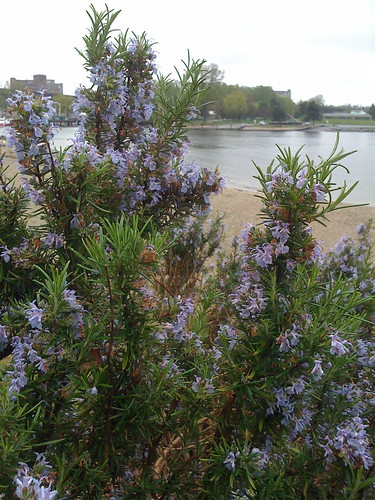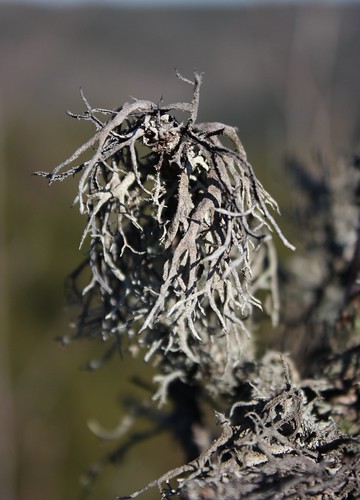Since the early 90’s, IFRA and other European regulatory organization have gradually tightened their embargo on the use of oakmoss in perfumes. Ever since than, slowly but surely, the rich heritage of Chypre is gradually collapsing. First, with the sneaky reformulation (partially rumours from devoted Chypre consumers, partially official statements from renown houses) of what seems to be all the mainstream chypre classics; Currently, the minimum amount of oakmoss allowed in a fragrance have reached the lowest of lows: a mere 0.1%. Reformulating all the classics –
Miss Dior, Jolie Madame,
Mitsouko – must have taken a few good years. It is now a sad but true common knowledge amongst fragrance aficionado that the chypre of today is not what we learned to love and cherish. This article, however, is about what we are gradually conditioned to perceive as the Chypre of Tomorrow.
The motives and the reasoning behind the IFRA regulations is something I prefer not to delve in. It opens up issues that are complex and quite puzzling, full of contradictions and conflict. Unfortunately, the recent developments in the Chypre world force me to open this Pandora Box at least a tiny bit, and I hope I will not be tempted to look back as I might just petrify right there and than. I will, however, refer you to
this article on Cropwatch, which addresses some of the issues that every modern perfumer that is interested in using certain natural aromatics is now facing.
Until very recently (perhaps just until last year), perfume labels were mysterious and vague. They usually looked like this:
Alcohol, Parfum (as shown on my box for Miss Dior parfum extrait from 4 years ago). If it happened to be an EDT or an EDP, there will also be “Aqua” in there. Occasionally, maybe, also a name of one other the other colouring agents.
Now they look like that:
Alcohol, Parfum (Fragrance), Aqua (Water), Hydroxycitronellal, linalool, alpha-isomethyl ionone, hydroxyisohexyl 3-cyclohexene carboxaldehyde, cinnamyl alcohol, coumarin, limonene, benzyl benzoate, benzyl alcohol, evernia furfuracea (treemoss) extract, citronellol, geraniol, evernia prunastri (oakmoss) extract, hexyl cinnamal, eugenol, amylcinnamal, cinnamal, benzyl salicylate.
(This is from the package of the Miss Dior EDT I bought a few weeks ago; and no, this is not the actual formula for the perfume inside the bottle, it’s just a list of all the ignredietns that are suspicious as allergens or sensitizers). My apologies for any spelling mistakes in the above list. Neither me or my computer know chemistry well enough to run a spell check through it.
But if you think that the solution for that lies in reformulation alone, you are mistaken. In the 90’s we have witnessed a new trend in perfumery, that was at first silent and polite towards the old-timers Chypres that we have learned to know and love (and spend lots of money on because they deserve it). Compositions that are not quite floral; not quite musky; not quite anything that we know really, and contain a safe 0% concentration of oakmoss; yet they have a certain appeal to the exact same perfume-user-group that adores Chypres. I can’t point out which scent has started it all, but lets just assume it was
Agent Provocateur (2000), a stunning seductress that gives off the impression of a classic floral-animalic Chypre of yesteryear, without using as much as a single drop of oakmoss or even labdanum for that matter. Agent Provocateur uses a combination of aldehydes, along with spicy and floral notes over a base of vetiver and musk to create a seamless, old-fashioned shamelessly erotic scent that fits with the Femme Fatale image of the lingerie brand that created it. Though the first impression of Agent Provocateur is very Cypre, in the last phase of dry down, there is none of the typical forest-floor, decay and earth-like warmth that is always found at the bottom of each true Chypre. Instead, we find a new kind of musk. A sensual musk, nevertheless, yet a clean and dry one, rather than the heavily warm and powdery suffocating musks of the era that Agent Provocateur reflects in its first phases of development.
What is to follow in the next seven years is a slowly but steadily growing number of releases that use the word chypre either as their classification or as a note. Yet there is no oakmoss (or labdanum) to be detected, and unlike Agent Provocateur, which ironically lived up to its name as a provocateur of the so-called new concept of Chypre. Lets assumed it was just sent out there to test the waters: would people notice if we DON’T use oakmoss? Would they still think it’s a Chypre? The answer is yes. But this is because Agent Procovateur is so well crafted and also has enough natural ingredients in it to resemble the rich floral bouquets at the heart of most Chypres that live up to their classification. What has followed is nothing shorter than horrifying, from a Chyprophile perspective.
Coco Mademoiselle (2001) has an alternating classification floriental or fruity-chypre. As charming as it may be (and this scent has wide fan-base) here is nothing in this composition to resemble Chypre even in the wildest of dreams. This younger sister of the bombshell oriental of 1984, Coco, maintains only a few ideas from the original, such as it’s expanding sillage that is equally sweet and spicy, charmingly bold yet with a certain unique transparency. Coco Mademoiselle is a concoction of fruity citrus, litchi and a marine accord over a floral heart and a base of clear patchouli, vetiver, musk and vanilla. But it couldn’t possibly have prepared us for the upfront sacrilege of what was about to come from the esteemed house of Chanel in 2003, in the form of a round Wheel-of-Fortune bottle of Chance. Chance is officially classified as a fruity chypre, and while it shares some similarities with Coco Mademoiselle, it fails to have any connection whatsoever with any true Chypre family member. Where this concoction of marine and fruity notes had let down many old-time Chanel fans it sure has attracted some new client base of (probably younger) consumers. With watery fruity-floral marine accord of pineapple, hyacinth, jasmine, and spicy pink pepper over a base vetiver (again) and patchouli (yet again) and musk, this is one slap in your face if you actually know what Chypre is. Of course, if you don’t, you might buy into it just the same as you would if you didn’t know that the whole idea behind keep all the bottles the same was a sign of classy minimalism and pure good taste. Which also happens to give more importance to the fragrance rather than the packaging.
Also in 2003, and this time classified as a Chypre-Floral – Escada Magnetism. This is more fruity than floral if you ask me, opening with mouthwatering pineapple, black currant, melon and litchi. The heart may be floral (official notes are magnolia, rose and jasmine) But don’t be deceived, this develops into something completely different and original (and I am not being sarcastic): once dried down, it’s the most sensational milky scent of orris, muted heliotrope, creamy sandalwood, and (although not listed as a note) white chocolate. Like other modern Chypre wannabes, this also has vetiver and patchouli at the base, though I can’t claim I noticed them too much. Again, no oakmoss in the horizon of this Roman milk bath.
Following the same train of thought of the two Cocos, we are now facing in 2006 something that couldn’t be more tragic:
Miss Dior is being blessed with a baby sister, but this time it is a vicious one who threatens to replace the original. The bottle design is very similar (unlike Chanel, who for the most part use the same bottle design for all their fragrances, Dior is known for coming up with very different designs for most of their creations; so the same bottle is a huge statement; and in a visual world like ours, many people accidentally miss the word “Cherie” at the end and buy it by mistake – for themselves or for others – while intending to purchase the original. Even the scent ribbons has that “New Look” – white stripes, yet with silver lettering). Miss Dior Cherie is now the “New Chypre”, classified as a fruity chypre, this time strawberries, paired with the less than agreeable combination of patchouli and caramel popocorn. The result, I am afraid to say, is horrid. Especially when knowing the chances that Miss Dior (the original lady) will survive are very slim - what with that glamorous looking sister around paired with the toning down of oakmoss in its reformulation.
Pure Turquoise by Ralph Lauren was launched this year as well (2006), the same year where we see the reformulation of many beloved all-time-classic Chypres. This scent is quite nice actually, with intense grapefruit top notes that linger longer than usual, and a very clean, dry base of refined (meaning very synthetic smelling) patchouli. In between there are all kinds of fantasy notes such as cactus flower and night blooming cereus and even rum (which I couldn’t find there at all). This is all nice and fun and refreshing, but to call this is Chypre is going completely overboard.
Another turning point was the release of Narciso Rodriguez For Her (2003). At first I was
ambivalent towards it not only because of its popularity, but also because it is a very obscure scent. Since than it has become a staple in my perfume wardrobe, and I couldn't agree more with what
Ms. Shortell had to say about it. Behind its prettiness hides quite a revolutionary concept and I am quite certain that a few decades down the road, it will be considered a milestone in fragrance history. This fragrance has a unique subtlety and is completely abstract (despite of the fact that certain “real plant essences” are listed in the brief, such as orange flower, osmanthus, vetiver). It’s a unique combination of manmade musk with abstract woods and florals. Although it’s categorized differently in different places, it was quite clear with defining the 2005 release of the Eau de Parfum version as a “Pink Chypre”.
Following Narciso Rodriguez we can now enjoy a few other scents that have a very similar concept – obscure florals, musky base with abstract, refind woody notes.
Lovely (2005) by Sarah Jessica Parker has musk paired with refined patchouli, crisp alcoholic apple notes and abstraction of Paperwhites (a species of narcissus); Kisu (2006) by Tann Rokka explores rosewood and cedar along with musk and an abstract ylang ylang note. Incidentally, this perfume was developed by Azzi Pickthall, the same nose who created Agent Provocateur.
The bottom line question is: are oakmoss and labdanum being replaced by synthetic patchouli, vetiver and musk as the necessary requirements for the Pink ((aka New) Chypre? And why would we do so when there are so many fragrances out there who has been using patchouli and vetiver for decades if not centuries, but were classified as oriental, woody or florals?
These last scents mentions (Narciso Rodriguez, Lovely, Kisu) are all unique fragrances that stand apart from other “pink chypres” (i.e. combinations of fruit, patchouli and vetiver) so to speak. They have something new to add to the perfume sphere. Classifying them as chypres poses a serious question about the reasons behind that. I am no paranoiac, but there might just be a silent scheme to gradually phase out the concept of Chypre and replace it with something new. I can see in my mind a boardroom full of perfume industry market researchers trying to figure out what is it they can give Chypre lovers that does not contain oakmoss. Perhaps they even did a cat scan of huge focus groups of chypre perfume users to find out what else they have in common, scent wise, besides oakmoss. Are perfume industry marketing professionals afraid of creating a new fragrance family with a new name? Or maybe, they just want to capitalize on the Chypre market just before they completely take away the real chypres? These questions, for now, remain unanswered, unless, of course, you attempt to answer them by leaving a comment.











